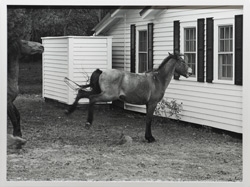A fugue of flowers and horses
Text: Yamauchi Hiroyasu
Off the coast of the US state of Georgia lies Cumberland Island, home to hundreds of once domesticated horses that over time turned wild. Roe Ethridge’s focus on this equine community resulted in his Horses series. Ten years before, he directed the aperture of a pinhole camera at what would come to form his Flowers. Ethridge’s solo exhibition, Goodnight Flowers, at the Rat Hole Gallery is structured around these two series.
 Horse by the House, 2008
Horse by the House, 2008Silver gelatin print, 101.6 × 134.6 cm
“The horse pictures were part of a story I shot for a travel magazine in December 2007. There’s a whole sad myth surrounding them: how they were owned by the Carnegies, abandoned in the early 1900s and are now feral – a situation fraught with its own sad set of problems. I love sad stories, but the context of the images has changed for me since; they are just pictures of horses now. The flowers are from a series I made slowly from 1995-1997. I had just finished college and had a 4 X 5 camera body with no lens. I also had no money, so I made a pinhole lens. The backgrounds are modified textiles, cheap fabric the patterns of which I ‘edited’ with acrylic paint. I bought the vases at a thrift store, painted them, and then would go to the farmers market and buy the cheapest flowers. I was really into the Becher school and anything ‘German photography’ at the time, but I was also into Matisse. I think I was trying to make a Matisse.”
Both series are very static, and appear to be scrupulously controlled. They strike the viewer as painterly photographs. Photography by nature, in dealing with reality, leaves tremendous leeway for accident. Is this something Ethridge takes great care to eliminate from his work?
“I love it when something good happens by accident. Take the red-check umbrella picture in this exhibition for example. I had been making pictures of plastic lattice that had the same check pattern as the umbrella, when I found it in the studio, left there by my assistant Marc. I think he said it had been left at his house by a friend. These little serendipitous events are constantly showing up in the work.”
Horses and flowers are both popular photographic subjects. And yet, one rarely sees them exhibited side by side.
“I suppose you could say flowers and horses are a weird combination (laughs). But they also have a lot in common. For one, they are both ubiquitous subjects for images, amateur and specialist alike. I’m comfortable with this kind of ‘pre-fab’ subject matter. And by juxtaposing it in the show, I make multiple voices sing – conceptually and pictorially. I’ve compared it in the past to the counterpoint of a fugue. By definition the word ‘fugue’ refers to both a musical composition and a psychological disorder – something like amnesia, where a person goes into a ‘fugue state’ for a few days and then wakes up somewhere else. I like both definitions in relation to the work. I like the idea of these disparate images making sense to each other in a musical way, of overlapping harmony and discord.”
Disparity there is. Between still life and animal, and a decade-long gap in production. And yet there is a tranquility common to both series, of capturing time inside the picture plane, that perhaps stems from their strikingly classical compositions. The American tradition in photography that began over 100 years ago with Alfred Stieglitz and his contemporaries runs unbroken through photographic expression in America today. Was it a strong awareness of this tradition that effected Ethridge’s style?
“Maybe skipping the 1950s and ’60s street snaps, the photography of the 1930s and ’40s, in which documentary and art both reside, is a place where I find inspiration. And Outerbridge has been a persistent reference for me recently. When I was in school I was trying to find a way out of American photography so I looked at a lot of contemporary German artists, Thomas Ruff and suchlike. Through the German stuff I discovered other historical examples of objective photography such as the ‘New Topographics’ of the 1970s and Walker Evans. I also played in a rock band when I was younger, so I guess my inspiration comes from many different directions. But photography is constantly stimulating me; I keep discovering more and more … like I just found out that Araki published eight books in 1982. That’s amazing!”

Roe Ethridge
Born 1969 in Miami. Currently based in New York. Known also as a commercial photographer. Participated in the 2008 Whitney Biennial. His first solo show in Japan is underway at the Rat Hole Gallery (Tokyo) through April 26.
Yamauchi Hiroyasu writes extensively on the subjects of photography and art.
